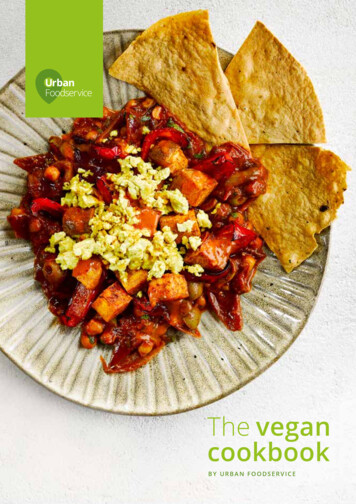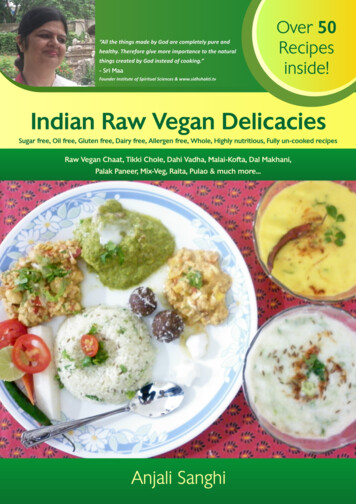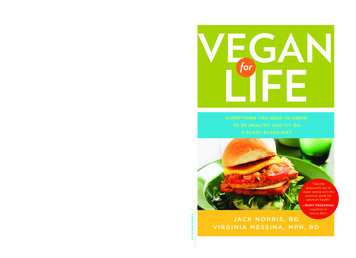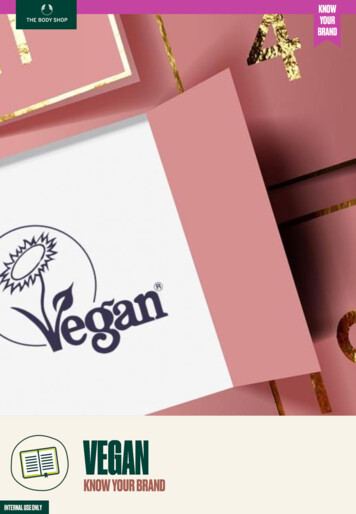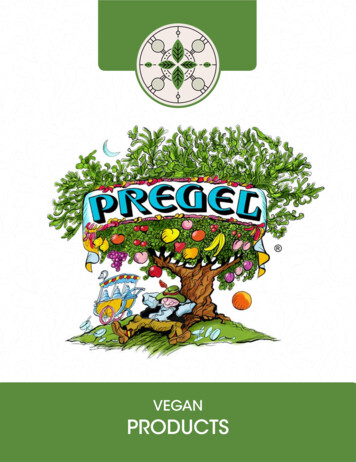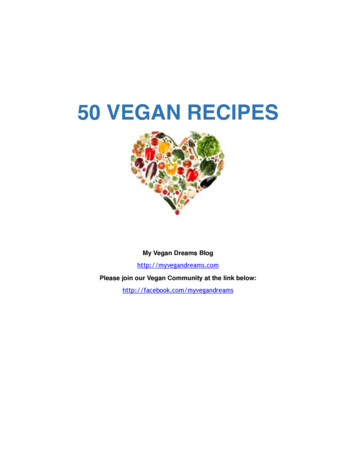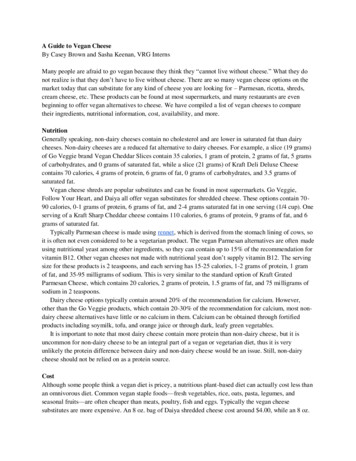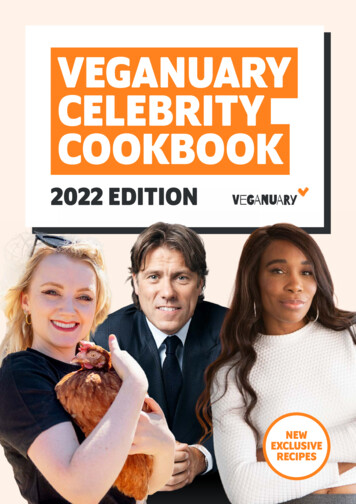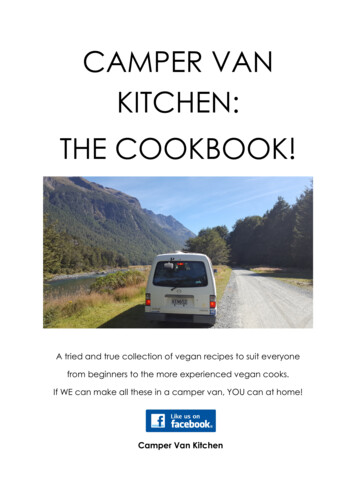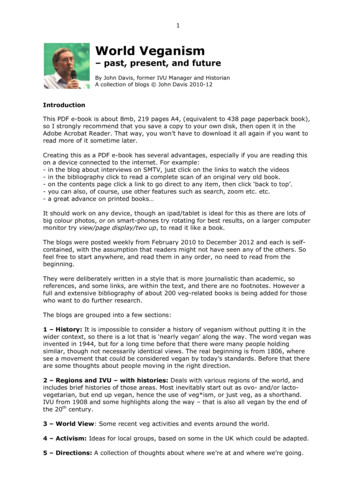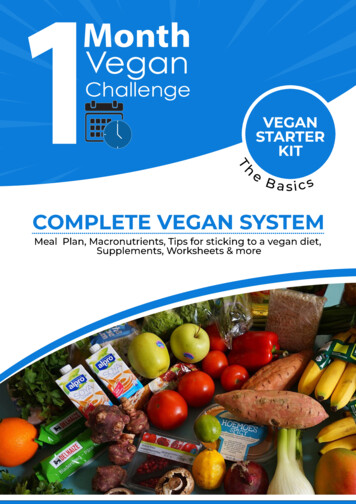
Transcription
VEGANSTARTERKITTheB a sic sCOMPLETE VEGAN SYSTEMMeal Plan, Macronutrients, Tips for sticking to a vegan diet,Supplements, Worksheets & more
Vegan Starter KitCONTENTSINTRODUCTION1WHAT THIS BOOK WILL DO FOR YOU?2WHAT TO EXPECT WHEN YOU MAKE THE SWITCH?3HOW TO DEAL WITH INTENSE EMOTIONS4HOW TO DEAL WITH BODILY CHANGES5HEALTH BENEFITS OF A VEGAN DIET6TYPICAL INGREDIENTS VEGAN’S EAT7EGG SUBSTITUTIONS:8REPLACING MILKS IN RECIPES11REPLACING BUTTER IN RECIPES12COMMON INGREDIENTS USED IN VEGAN RECIPES14HIDDEN ANIMAL INGREDIENTS TO LOOK OUT FOR21MORE INGREDIENTS TO AVOID24GUIDE TO STOCK YOUR VEGAN PANTRY23ESSENTIAL VEGAN FOOD ITEMS TO HAVE IN YOUR KITCHEN25VEGAN COOKING GUIDE27SETTING UP YOUR KITCHEN28HOW TO FOLLOW RECIPES31LEARN HOW TO USE YOUR KNIVES32
1Vegan Starter KitINTRODUCTIONThe people on our modern society are concerned with multiple issues. Health and theenvironment are two very big ones that are at the forefront. People want to eat well andlessen their environmental impact. Threats of global warming and obesity run are two ofthe biggest concerns.Some people decide they want to tackle both at the same time. Making the choice tobecome a vegan is a decision that is made just as much for health reasons as well asenvironmental and ethical ones.By taking the 1 month vegan challenge will will begin to experience all the health benefitsand also be ideally positioned to embrace veganism as a permanent lifestyleThis guide will give to you an easy overview of what you will be doing, what you shouldexpect, what you will need to purchase, and what you need to get started.In all honesty, the first 3 weeks won’t be easy because you will be training your body towork in a new way.After 3 weeks you of course still won’t know half the tips and tricks a vegan of ten yearswill know, but you’ll nevertheless be well past the tricky part and nicely equipped to stayvegan if that’s what you want to doFollow the steps laid out in this guide to maximize your chances of being successful.SO, WHAT DOES IT MEAN TO BE VEGAN. ANYWAY?Vegan is a subset of vegetarianism. There are several different types. Some vegetariansstill drink milk and/or eat eggs. Not vegans. They are the strictest form and don’t makeallowance for ANY animal products in their diet.It is by far the most challenging form because people take a lot of things for granted.Eggs and milk, for example, are common baking ingredients. So, substitutions need to bemade if a vegan is going to be able to eat baked goods.Return to Contents Table
2Vegan Starter KitWHAT THIS BOOK WILL DO FOR YOU?There’s no doubt that a vegan diet is great for your health. However, with the popularityof health food stores due to the fact that many are looking to improve their health, it’seasier than ever to enjoy a satisfying vegan diet. This eBook will teach you how to do that. The basics on how to cook vegan food the right way. An overview of typical ingredients used in vegan cooking. A list of hidden ingredients to avoid while eating a vegan diet. Also includes information on how to stock a complete vegan pantry so you can preparevegan dishes everyday without a hassle. Will cover basic cooking techniques needed to create a variety of satisfying meals. How to put together a complete vegan meal while getting the right balance vitamins,minerals, and nutrients for your body. What to do if you have special nutritional needs such as those who have diabetes orhigh cholesterol. With over 50 vegan recipes to choose from in your 30 day challenge, makes it easy toget started straight away!As you can see, there’s a lot of information to take in on how to enjoy a vegan diet. ThiseBook is designed to teach you everything you need to know.Return to Contents Table
3Vegan Starter KitWHAT TO EXPECT WHEN YOU MAKE THE SWITCHWhen you make the switch to a vegan diet, a lotof things change. When you decide to eat onlyvegan food, your body will need time to adaptto it.But not to worry this is a good thing. Byremoving all animal products from your diet isone of the best health choices you could make.Just the concept of eating more plant-basedfoods instead of animal products is a great wayto enhance your longevity, balance your moods,optimize your taste buds to crave healthierfoods and reducing the risk of well knowndiseases that a lot of people suffer from.But it’s not all Rainbows and Sunshine when you transition to a vegan diet, despite everyhealth benefit you have heard or have experienced so far.Many people who transition into a plant-based diet go through a detox period.Not your typical detox diet where you skip out on meals or just drink juice all week,detoxing from animal-based products is a real issue that you need to be aware of.It can include headaches, digestion changes, and even feelings of sadness as you learn tolet go of old traditions surrounding meals with meat, dairy, eggs or poultry and get usedto the concept of eating different foods than you might be used to.That’s why during the 30 day vegan challenge, try to observe any changes that mightoccur in your body and be attentive to your needs. Plenty of rest, and drinking lots ofwater will be a big help.Return to Contents Table
4Vegan Starter KitHOW TO DEAL WITH INTENSE EMOTIONSWhen you take the 1 Month Vegan Challenge,you may experience a wide array of emotionsand shifts in thinking ranging from excitementto sadness to guilt.Many people don’t realize how much they’reemotionally tied to certain foods. For instance, ifone of your most favorite memories is sittingdown and enjoy chicken or beef burgers atthe table with your parents as a kid, or having aplate of mom or grandma’s bacon and eggs onSaturday mornings makes you just smile withwarmth and good emotions, the idea of noteating these dishes anymore can be a littledepressing.But realize that you’re not attached to the food; you’re attached to the memory aroundthe food that enhances the strength of that emotion.Physiologically speaking, your body’s hormones also change when you quit eating animalproducts and many people’s bodies are more sensitive than others. As hormones changeand stabilize, realize that emotional changes are normal.One unique thing to point out is that a plant-based diet can be very mind-clearing due tothe way it sweeps out excess hormones from animal-based foods in the body.As it does this, the body can go through almost a shock emotionally and physically. Ifyou are experiencing emotional changes, know that it’s completely normal, and don’t beafraid.See some tips for transitioning away from your favorite traditional meals, and exploreHow Your Food Choices Affect Your Hormones to learn more about the physiologicalchanges that happen when you quit eating animal proteins.Return to Contents Table
5Vegan Starter KitHOW TO DEAL WITH BODILY CHANGESAs your body cleanses itself from many sources of harmful animal protein stored in yourcells, keep in mind that your liver, digestive system, kidneys, and lymph system are inmajor “cleaning house” mode.Be aware of this and know that because they’re sweeping all that out without you eatingany more of those foods to slow the detox down, you’ll likely be a little (or a lot) moretired than usual, may experienced increased bathroom time (which is a good thing!),and may even have headaches. It feels a little like the flu and can be exhausting in thebeginning if your diet was especially toxic before.These are all signs your body is cleaning itself; be patient and wait things out, they do getbetter!Be sure you eat a very clean diet with very little processed foods during this time ifpossible. This will better allow your body to do its job so you can feel your best muchmore quickly. Remember, the cleaner the food you give your body, the better it can usefood to detoxify and supply you with nutrients for fuel.Greens, fruits, vegetables, raw nuts and seeds and their milks and butters, complexcarbs from gluten-free grains and root vegetables, beans, legumes, along with healthyfats like olives, coconut, nuts, and avocado are all great choices. Be sure you take inadequate protein from seeds, greens, many grains, and keep in mind that all greens andvegetables have protein too.See some digestion troubleshooting tips here if you have some especially uncomfortableissues going on.Return to Contents Table
6Vegan Starter KitHEALTH BENEFITS OF A VEGAN DIETBetter Mood:Research is suggesting they are happier than meat eaters.Disease Fighting:When done right the diet is naturally low in fat and cholesterol, and has been shown toreduce heart disease risk. Epidemiological data has shown vegetarians suffer less fromdiseases caused by modern western diet (coronary heart disease, hypertension, obesity,type 2 diabetes and cancers).This must be attributed to a higher intake of fiber, phytonutrients and Antioxidants.Lean Figure:Vegans typically weigh less as a result from a diet that has fewer calories in the form ofgrains, legumes, nuts, seeds, fruits and vegetables.Less Toxicity:Plant sources are safer than animal foods. Particularly when consuming organic fruitsand vegetables.Food borne illnesses, antibiotics, bacteria, parasites and chemical toxins are morecommon in commercial meat, poultry and seafood when compared to plant foods.Saving the Planet:Plant based diet is better for the planet as it requires less energy and farm land to feed avegetarian.Sight:Vegans tend to have better sight.Money Saving:Plant foods tend to be less expensive except for a few delicacies.Better Athletic Performances:A high carb/low fat and vitamin and mineral rich vegetarian diet may be the optimal forsport performance.Supporting Animal Rights:Animal welfare is improved.Longevity:Vegans have been found to enjoy longer and healthier lives when compared to meateatersReturn to Contents Table
7Vegan Starter KitTYPICAL INGREDIENTS VEGAN’S EATAs you know, vegan cooking is done without meat, fish, eggs, or byproducts of any ofthese things. In order to support a vegan lifestyle, extra care needs to be taken to makesure that none of these ingredients makes it into the food.We take certain things for granted, such as using eggs while baking. Well, eggs arenot allowed during a vegan diet. And even though the vegan lifestyle is increasing inpopularity, packaged vegan food are often hard to come by. To solve this problem, manyvegans opt to do their own cooking.This chapter will focus on several different kinds of ingredients. First, we’ll learn how toreplace milk and eggs with things that are vegan friendly. We’ll also cover information onother ingredients that are used as well as animal byproducts to watch out for.REPLACING EGGS IN RECIPESAs much as we’d like to avoid using eggs in our vegan recipes, it can be a challenge. In fact,this is one of the most difficult ingredients to replace. However, there are many options tochoose from that will get the job done.WHAT DO EGGS DO IN THE RECIPE?In certain recipes, eggs are almost essential. They bind ingredients together. They can beused to make baked goods rise and they also help make them light and fluffy. Anotherthing eggs do is to help the product form some structure and also provide extra moisture.They are especially useful while baking but are essential to certain savory dishes as well.Return to Contents Table
8Vegan Starter KitEGG SUBSTITUTIONS:Here is a list of some of the best egg replacement options out there. You can replace theeggs in any recipe using these options.BANANA PUREEGROUND FLAXSEEDPureed bananas are another effectiveegg substitute. Just place a rip banana inthe blender and pulse until completelysmooth and there are no lumps. A half ofa regular sized banana is the equivalentof one egg. The positive aspect of usingbananas is that they are readily available.However, bananas have a distinct tastethat won’t work out in every recipe. Forexample, if you were trying to makepeanut butter cookies, the banana flavorwould alter the taste.It is best to purchase the flaxseeds wholeand store them in the refrigerator. Whenit’s time to use them, measure out 1tablespoon of flaxseeds for every eggthat you need to replace. Then, pulverizeit in a blender or coffee grinder. Transferthe flaxseeds to a bowl and add threetablespoons of water for each egg youneed to replace. Add the water slowlywhile whisking vigorously. Whisk until themixture takes on a gel-like quality. Sinceflaxseeds are nutty tasting and worksbest when making things like whole grainbreads, muffins, and pancakes.Return to Contents Table
9Vegan Starter KitEGG REPLACERSTOFUNowadays there are plenty of eggReplacers that are available to buy atyour grocery store. They are an easy-touse vegan baking essential. The packagecontains instructions for using as asubstitute for whole eggs and separatedegg whites or yolks. It’s great for muffins,cakes, cookies, quickbreads and more.Tofu is also another option you can try ifyou need to find a replacement product.You can try any form of tofu but thismay take some experimentation. Silkentofu seems to yield the best results. Tofudoesn’t have a lot of flavor on its own,especially when paired with strongeringredients. Another advantage is that itis widely available in most areas, even inthe regular supermarkets.To use, just take the tofu and blend it untilsmooth in the blender. Food processoralso may work but it’s important to makesure that there are no lumps and thetexture is as smooth as possible.To replace one large egg, use ¼ cup of theblended mixture. You’ll need to do someexperimenting to see which recipes workbest with tofu as an egg substitute. It alldepends on the kinds of recipes you tryand your personal preferences.Return to Contents Table
10Vegan Starter KitUSING FLOUR AND OTHERLEAVENING AGENTSYou can also use pastes made fromdifferent kinds of flours and leaveningagents to replace the eggs.The benefit is that most homes havethese ingredients on hand. They alsodon’t have flavor of their own like bananasand flaxseeds do. They can blend into thebatter fairly well.Tofu iscan try if youIt alsomayanothertake optionsome youexperimentationneed toproduct.right.You canHeretryto findgeta replacementthe proportionsany formof tofuoptions:but this may take some experare someimentation. Silken tofu seems to yield the best1 Tofutablespoonfloura ofanyflavorkindon(tryresults.doesn’t havelot ofitsflour,flour,withor strongersoy flour)own, wheatespeciallywhenoatpairedinand 1Anothertablespoonwater isforthateachgredients.advantageit isegg.widelyavailable in most areas, even in the regular supermarkets.1 tablespoon baking powder, 1tablespoonflour,2tablespoonsTo use,justtakethetofuandblendit untilwater for each egg.smooth in the blender. Food processor also maywork but it’s important to make sure that there2 lumpstablespoonscorn starchand as2are noand the textureis as smoothtablespoons water blended togetherpossible.also replaces one egg.To replace one large egg, use ¼ cup of the blended mixture. You’ll need to do some experimenting to see which recipes work best with tofu asan egg substitute. It all depends on the kinds ofrecipes you try and your personal preferences.Return to Contents Table
11Vegan Starter KitREPLACING MILKS IN RECIPESFor a vegan, milk from any animal (sheep, cow, goat, etc) is also forbidden. It is also avery common ingredient when baking and cooking. It is also much easier to replace thaneggs.To replace milk in recipes, just substitute any of these vegan alternatives.For example, if the recipe calls for one cup of milk, use one cup of soy milk instead. Hereare some alternative milk options:SOY MILKNUT MILKSRICE MILKSoy milk comes in a varietyof flavors and is readilyavailable. Flavors includevanilla,unsweetened,chocolate, and even eggnog. Some brands arethicker and creamier thanothers. You may need todosomeexperimentingbefore you find the brandsyou like the best. Unless ithas a distinct flavoring, soymilk is fairly neutral andblends well in recipes. Soymilk is also rich in protein.Nut milk beverages suchasalmondmilkandhazelnut milk are alsooptions. Unlike soy milk,these nut milks have adistinct flavor and may notwork well in every recipe.There are sweetened andunsweetened varieties aswell.Rice milk also offers a greatoption to replace milk inrecipes. It is also very mildtasting and blends well inrecipes.Return to Contents Table
12Vegan Starter KitREPLACING BUTTER IN RECIPESButter is another important ingredient that a lot of recipes call for. There are severaldifferent things you can do in order to substitute it:VEGETABLE OILVEGETABLE SHORTENINGIf the recipe calls for melted, or even solid,butter you can consider using vegetableoil instead. This, however, may alter thetexture of the recipe a little so you willprobably need to experiment.If you really need a solid fat to use in recipesyou can use vegan-friendly shortening.This is a manufactured product and filledwith transfats, however. So, using it inmoderation is best. Shortening isn’t goodfor you at all! You can also find butterflavored shortening where a butter flavoris required.Return to Contents Table
13Vegan Starter KitMARGARINEFRUIT PUREESThis is another option that can replacebutter or other solid fats, especiallyif you want something with a butteryflavor. However, margarine is also high intransfatty acids. Watch for transfat-freeproducts, but even those may containtrace amounts of transfats.You can also reduce fat with fruit purees.For example, if the recipe calls for 1 cupof butter, you can try using ½ cup applesauce and ½ cup vegan margarine orshortening. Other fruit purees you canuse include plum puree and bananapuree. You may be able to find fruit pureefat replacement products in the store.Just make sure they are vegan friendlyand that you follow the instructions formaking a proper substitution. You mayalso want to try replacing all the fat in therecipe with fruit. However, this may alterthe texture too much.Return to Contents Table
14Vegan Starter KitCOMMON INGREDIENTS USED IN VEGAN RECIPESVegan cooking is certainly an art. As illustrated in the previous section, ingredients suchas milk, buttermilk, eggs, and butter are almost essential for certain recipes.But, as we explored, the substitutions are more than adequate. With that said, there area lot of ingredients that a lot of vegan chefs find essential.Here’s a rundown of some of the most common.SOY PRODUCTSSOY MILKSoy is probably the most versatile plant out there, especiallywhen it comes to creating healthy and protein rich veganmeals. Here is a list of some of the soy products that are outthere:TOFUGROUND BEEFREPLACEMENTTofu comes in different levelsof firmness such as extra firm,or soft.This soy food is a staple tosome, because you can makemeals such as SpaghettiBolognese and vegan chili.Return to Contents TableMISOMiso is a fermented saltypaste that is made from soyand is used as a popular,enzyme rich soup base.
15Vegan Starter KitTAMARI AND SOYSAUCETomari and Soy Sauce arecondiments are made fromsoy.SOY SAUSAGESSoy sausage, hot dogs, andhamburger patties Vegans canenjoy breakfast sausage, hotdogs, and even hamburgerpatties.Return to Contents TableEDEMAMEThese are the fresh soybeans and are excellent bythemselves or in stir fries.SOY CHICKENSoy “chicken” They come ina variety of forms such aspatties, nuggets, etc.SOY CHEESESoy cheese even melts andhas a similar texture as realcheese.SOY PROTEIN POWDERSoy protein powder Soyprotein offers a great way toincrease your daily proteinintake. You can put a scoopin your morning smoothie,or add it to recipes such aspancakes and breads.
16Vegan Starter KitSOY FLOURThere are a variety of soy products out there and this wasn’tnecessarily a complete list. It just illustrates the versatility ofthe food product. Look for soy products that are used fromnongenetically modified soy beans.But, soy foods have their critics. Some only like to use them intheir “traditional” forms such as tofu, tempeh, miso, edemame,and tamari.Soy flour is also a valuableproduct, particularly forbaking.Opponents of processed soy products are leery of the fact thatthey are designed to taste like meat or milk products which tothem, defeats the purpose of being vegan. Plus, these foodstend to be highly processed which doesn’t necessarily makethem healthier. Whether or not you decide to use them is adecision that you should make after you weigh the pros andcons.WHOLE GRAINSThere are so many different kinds of whole grains out there, it is worthwhile toexperiment. Grains are rich in vitamins, minerals, fiber, and other important nutrients.They even have protein, especially quinoa – an ancient grain that is especially proteinrich. Here are some whole grain products to try:BARLEYReturn to Contents TableBUCKWHEATBULGUROATS
17Vegan Starter KitQUINOAWILD RICEBLACK RICENUTS & SEEDSThese are another essential part of a healthy vegan diet. They are rich in vitamins andminerals as well as important nutrients like healthy fats.Here’s a list of some nuts and seeds to try:HAZELNUTSReturn to Contents TableWALNUTSSUNFLOWERSEEDSPECANS
18Vegan Starter KitALMONDSSESAME SEEDSCASHEWSFLAX SEEDHEMP SEEDYou can include them in recipes and also eat them by themselves as a snack.Return to Contents Table
19Vegan Starter KitLEGUMESLegumes are an essential protein source to a vegan, especially when paired with wholegrains. They need to be combined in this way in order to form a complete protein. Whenthis is one of your main protein sources, it is important to remember to combine it.KIDNEY BEANSCHICKPEASBLACK BEANSBLACK EYEDPEASPUPINS BEANSSPLIT PEASCANNELLLONIBEANSFAVA BEANSYou can find legumes in dried form, ground into flour, and canned. The dried form needsto be soaked overnight in order to soften it. The canned form is easy to use and great tohave on hand. The flour is also a popular ingredient in baked foods and savory cooking.Return to Contents Table
20Vegan Starter KitFRUITS & VEGETABLESImportant for good health, fruits and vegetables add color and variety to your meals. Asa vegan, your entire diet will be plant based so you need to get your vitamins, minerals,and nutrients from things like fruits and vegetables.Look for organic produce whenever possible which makes them even healthier. Organicfood is also better for the environment. Seasonal, local produce is also best because ithelps support your local economy and tastes a lot fresher.CANNED AND PACKAGED FOODSAs the vegan diet increases in popularity, so does the availability of packaged, veganfriendly foods. What follows is a list of some of the things you can find.BREADSBAKED GOODSCANNED TFOODSThe great thing is that you don’t even need to go to a health food store to find a lot ofthese products.Yes, health food stores have a lot of vegan options, but you can even find vegan productsin your regular supermarket.Return to Contents Table
21Vegan Starter KitHIDDEN ANIMAL INGREDIENTS TO LOOK OUT FORAs mentioned in a previous section, there are often hidden ingredients in foods that areanimal byproducts. A true vegan will take the extra step needed to investigate what theseingredients are and avoid them.If it is a packaged food and it is listed as being vegan friendly, you can be fairly confidentthat the food doesn’t have these ingredients in it. But, it is still a good idea to check.What follows is a list of the ingredients to watch out for. There are two types ofingredients – those that are clearly from animal products, and those that may be fromanimal products or may be from plant derived products.In the second category, the only way to really find out is by contacting the manufacturerof the food product. And if they don’t know, consider not buying their product just to besafe.A LIST OF SNEAKY NON-VEGAN INGREDIENTSThese ingredients are fairly common in foods so unless a product is labeled as vegan,you should really check the ingredients list to make sure they aren’t included.Albumin:It comes from egg whitesMilk products:It includes whey protein powder, lactase, lactose, and things like milk and dried milkCalcium Caseinate:It is a fairly common additiveCalcium Stearate:It is also another additiveSuet:It is a type of animal fatTallow:It is animal fat product and is made from suetBee products:This includes royal jelly, propolis, honey, and bee pollenCarmine:It is a food additive that comes from insectsReturn to Contents Table
22Vegan Starter KitLard:It is a type of animal fatCasein:This is the protein that is in cheeseGelatin:From animals, a popular product found especially in jellies and dessertsOther common hidden ingredients from animals include:Cochineal Isinglass Muristic acid Oleic acid Palmitic acid Pancreatin Pepsin Most of theabove ingredients are typically used as additives in food. They have different purposes,depending on the food that it will go on.MORE INGREDIENTS TO AVOIDThe following ingredients serve different functions in the food that they are in. Some areconsidered additives. Others emulsify foods and supply extra fats.However, just because it sounds like an animal ingredient, doesn’t mean it is. They couldbe synthetically manufactured or come from plants. You’ll need to check.THE INGREDIENTS INCLUDE:Adipic acid:Emulsifying agentsFatty acidGlycerolCapric acidMagnesium stearateLactic acidGlycerideMonoglycerideAnything listed as“natural flavoring”Disodium inosinateClarifying agentsGlycerideStearic acidDiglycerideGlycerolPolysorbateSodium stearoyllactylateYes, some of those ingredients are hard to say – some of them don’t even sound like food! They all havedifferent purposes in the foods that we eat on a daily basis, even foods that we don’t think to consider.The point is that if you want to live a truly vegan lifestyle, it is worth the extra step to follow up and determine if your favorite foods use the animal versions of these ingredients.However, it is important to understand that the ingredients mentioned in this section can be found inalmost everything. If you try to focus too much on it, it may get too overwhelming.It is important to find a good balance between wanted to be a strict vegan and living a fulfilling life. Ifthings go too far, it could affect your health in a negative way from the stress.Being a vegan is definitely a lifestyle commitment. Learning about the foods you need to eat, how tomake vegan friendly substitutions while baking and cooking, and all about the ingredients you maywant to avoid are all necessary part of embracing the vegan lifestyle.Return to Contents Table
23Vegan Starter KitGUIDE TO STOCK YOUR VEGAN PANTRYSetting up your pantry is an essential step to being able to easily create meals on a whim.For people who have been vegetarians all their lives, setting up the pantry will not be astruggle. However, if you’ve just recently converted to a vegan, you’ll probably need tostart from scratch. You may have some ingredients on hand, but most of your pantrymay not be vegan friendly.Of course, this list will not include perishable items such as fruits and vegetables.However, even some perishable items, such as certain brands of tofu, soy milk, rice milk,almond milk, etc can be stored on the shelves and not in the refrigerator because of thespecial packaging.Step 1: Take inventoryThe first step to building a vegan pantry is to take inventory of what you have. This stepis mostly for those who have just become vegans. However, if you have been vegan for awhile, you will also benefit from this. The goal is to go through and think about everythingthat you have and determine if it supports the vegan lifestyle.You may also want to look at the ingredients lists of all your packaged foods to determineif any of the hidden ingredients listed in the previous chapter exist. Even if you have beenvegan for a while, you may still find some foods in your pantry that you should not havethere.If you do find a lot of foods to get rid of and they have not been opened, do not throw themaway. Give them away to a local food pantry. Just because you will not eat them does notmean that someone will not benefit from them and appreciate having something to eat.Step 2: Stock the essentialsIt isn’t entirely necessary to have a large pantry filled with tons of ingredients and packaged foods.All you need to do is sit and think about the things that are really important to you. If you don’t bakethat often, for example, don’t bother buying baking supplies untilyou really need them.If you are the type of person who loves cereal and has a few bowls a day, you may want toReturn to Contents Table
24Vegan Starter Kitkeep packages of nut milk, soy milk, rice milk, and extra cereal in your pantry so you don’tneed to run to the store all the time.Once you figure out what you need and what your eating preferences are then you canstart buying things to put in your pantry. If you do not take the extra time to think aboutwhat you need, you’ll end up purchasing things you won’t eat. Then, the food will go towaste. Just stock the essentials and if you need other things, you can buy them as you goalong.Step 3: Purchase any extrasIt can be expensive to stock your pantry all at once. There are certain ingredients thatyou may need once in a while, such as tomato sauce and other items. It isn’t importantto buy some of these extras at first. You can add to your pantry gradually as you goshopping or as you realize you need them.In general, it is nice to have the ingredients on hand to make a few simple meals suchas pasta dishes, soups, and grain and legume dinners such as rice and beans. Thinkabout the kinds of foods you like to eat and purchase the extra ingredients to havethem on hand.If you are on a tight budget, you can take care of these items as you go along. Planyour meals in advance and write out a shopping list. You can buy these extras at thebeginning of the week and store them as you buy them.Return to Contents Table
25Vegan Starter Ki
The basics on how to cook vegan food the right way. An overview of typical ingredients used in vegan cooking. A list of hidden ingredients to avoid while eating a vegan diet. Will cover basic cooking techniques needed to create a variety of satisfying meals. Also includes information on how to stock a
